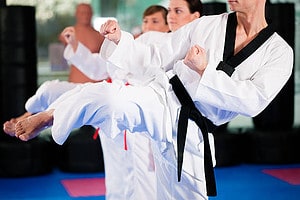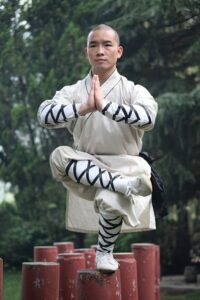How to choose a martial art to study?
Table of Contents
-
-
Introduction
-
Research the Different Types of Martial Arts: Understand the different styles of martial arts and the philosophies behind them to determine which one is right for you
-
Consider Your Goals: Think about what you want to get out of martial arts and how it will fit into your lifestyle
-
Find a Good Instructor: Look for a qualified instructor who can help you reach your goals and provide a safe learning environment
-
Consider Your Physical Ability: Different martial arts require different levels of physical fitness, so make sure you choose one that is appropriate for your current level of fitness
-
Consider Your Budget: Different martial arts have different costs associated with them, so make sure you factor in the cost of equipment, classes, and other fees when making your decision
-
Conclusion
-
Introduction
When it comes to choosing a martial art to study, there are many factors to consider. It is important to think about your goals, the type of martial art, the cost, the availability of classes, and the instructor. Additionally, it is important to consider the physical and mental demands of the martial art, as well as the safety protocols in place. By taking the time to research and consider all of these factors, you can make an informed decision about which martial art is right for you.
Research the Different Types of Martial Arts: Understand the different styles of martial arts and the philosophies behind them to determine which one is right for you
Martial arts are a form of physical activity that involve the use of techniques such as striking, grappling, and blocking to defend oneself or attack an opponent. There are many different styles of martial arts, each with its own unique philosophy and approach to combat.
Karate is a Japanese martial art that focuses on striking techniques such as punches, kicks, and blocks. It emphasizes the development of physical strength, speed, and agility, as well as mental discipline and focus. Karate is often used in self-defense situations and is a popular form of exercise.
Judo is a Japanese martial art that focuses on grappling techniques such as throws, joint locks, and chokes. It emphasizes the use of leverage and balance to control an opponent, rather than relying on physical strength. Judo is often used in competitive sports and is a popular form of exercise.
Taekwondo is a Korean martial art that focuses on kicking techniques such as roundhouse kicks, spinning kicks, and jump kicks. It emphasizes the development of physical strength, speed, and agility, as well as mental discipline and focus. Taekwondo is often used in self-defense situations and is a popular form of exercise.
Kung Fu is a Chinese martial art that focuses on a variety of techniques such as striking, grappling, and weapons. It emphasizes the development of physical strength, speed, and agility, as well as mental discipline and focus. Kung Fu is often used in self-defense situations and is a popular form of exercise.
Aikido is a Japanese martial art that focuses on blending with an opponent’s movements and using their energy against them. It emphasizes the use of leverage and balance to control an opponent, rather than relying on physical strength. Aikido is often used in self-defense situations and is a popular form of exercise.
Brazilian Jiu-Jitsu is a Brazilian martial art that focuses on grappling techniques such as throws, joint locks, and chokes. It emphasizes the use of leverage and balance to control an opponent, rather than relying on physical strength. Brazilian Jiu-Jitsu is often used in competitive sports and is a popular form of exercise.
These are just a few of the many different styles of martial arts available. Each style has its own unique philosophy and approach to combat, so it is important to research and understand the different styles before deciding which one is right for you.
Consider Your Goals: Think about what you want to get out of martial arts and how it will fit into your lifestyle
Martial arts can be an excellent way to improve your physical and mental health, as well as to learn self-defense. Before beginning a martial arts program, it is important to consider your goals and how it will fit into your lifestyle.
If you are looking to improve your physical fitness, martial arts can be a great way to do so. Many martial arts styles involve a combination of aerobic and anaerobic exercises, as well as strength and flexibility training. This can help you to build muscle, increase your endurance, and improve your overall physical health.
If you are looking to learn self-defense, martial arts can also be a great option. Many martial arts styles focus on teaching self-defense techniques, such as blocking, striking, and grappling. This can help you to feel more confident and secure in potentially dangerous situations.
Finally, martial arts can also be a great way to improve your mental health. Many martial arts styles involve meditation and mindfulness practices, which can help to reduce stress and anxiety. Additionally, martial arts can help to improve focus and concentration, as well as provide a sense of accomplishment and purpose.
When considering a martial arts program, it is important to think about how it will fit into your lifestyle. Consider the time commitment involved, as well as the cost and location of classes. Additionally, think about the type of martial arts style that best suits your goals and interests.
By taking the time to consider your goals and lifestyle, you can ensure that you find the right martial arts program for you.
Find a Good Instructor: Look for a qualified instructor who can help you reach your goals and provide a safe learning environment
Finding a good instructor is essential for anyone looking to learn a new skill or improve their existing abilities. When searching for an instructor, it is important to look for someone who is qualified and experienced in the field. Researching their credentials and background can help you determine if they are the right fit for you. Additionally, it is important to find an instructor who can provide a safe and comfortable learning environment. Ask questions about their teaching methods and approach to ensure that they are the right fit for your needs. Finally, make sure that the instructor is able to help you reach your goals and provide the support and guidance you need to succeed. With the right instructor, you can be sure that you will be able to reach your goals and gain the skills you need to succeed.
Consider Your Physical Ability: Different martial arts require different levels of physical fitness, so make sure you choose one that is appropriate for your current level of fitness
When selecting a martial art, it is important to consider your physical ability. Different martial arts require different levels of physical fitness, and it is important to choose one that is appropriate for your current level of fitness. For example, some martial arts require a high level of physical strength and agility, while others are more focused on technique and strategy. It is important to assess your current physical fitness level and choose a martial art that is suitable for your abilities. Additionally, it is important to remember that martial arts can be physically demanding, so it is important to ensure that you are able to commit to the necessary training and practice.
Consider Your Budget: Different martial arts have different costs associated with them, so make sure you factor in the cost of equipment, classes, and other fees when making your decision
When deciding which martial art to pursue, it is important to consider your budget. Different martial arts have different costs associated with them, including equipment, classes, and other fees. For example, karate may require the purchase of a uniform and protective gear, while judo may require a judogi, or judo uniform. Additionally, classes may be offered at different price points, depending on the instructor and the school. It is important to research the costs associated with each martial art before making a decision.
In addition to the cost of classes and equipment, there may be other fees associated with the martial art. For instance, some martial arts may require a membership fee or a fee for testing and certification. It is important to factor in these costs when making your decision.
Finally, it is important to consider the long-term costs associated with the martial art. For instance, if you plan to compete in tournaments, you may need to purchase additional equipment or pay for travel expenses. Additionally, if you plan to pursue a higher rank, you may need to pay for additional classes or testing fees.
By taking the time to consider the costs associated with each martial art, you can make an informed decision that fits within your budget.
Conclusion
When deciding what martial art to study, it is important to consider your goals, the style of the martial art, the instructor, the cost, and the time commitment. It is also important to consider your physical abilities and limitations, as well as your personal preferences. Ultimately, the best martial art for you is the one that meets your needs and interests. With the right research and dedication, you can find the perfect martial art for you.







